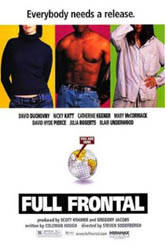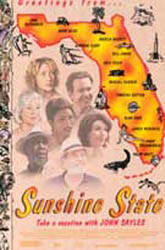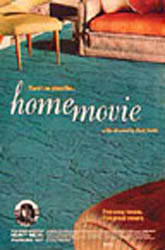 Director: Starring:
OTHER REVIEWS: Code
Unknown Magnolia Mulholland
Dr. Time
Code |
Full Frontal BY: DAVID PERRY At the end of Steven Soderbergh's Full Frontal, there is a title card proudly proclaiming that the film was edited with Apple's Final Cut Pro software much in the same way a title card said the same thing about Tim Robbins' Dead Man Walking begrudgingly using antiquated editing machines. For Robbins, it was a problem of using faulty established machines; for Soderbergh it is pride in getting to toy with something so anti- establishment. That is the tone throughout Full Frontal, that this is a movie about going against the Hollywood establishment. Soderbergh has never really been one within the crowd -- at least, that is, until two years ago when people actually noticed how good his films were -- and actually spent much of his early years criticizing the hands the fed him. After he went through the therapy of his flop Schizopolis, Soderbergh came back as more of a bankable director. More importantly, though, he was more artistically sure of his work than ever before. Full Frontal goes against this, partly because it is a movie meant to allow the director freedom to do anything and everything he's wanted to do since Schizopolis. While he's been churning out incredible (and profitable) films like Out of Sight, The Limey, Erin Brockovich, Traffic, and Ocean's 11, he's evidently had fears about "selling out." None of those movies were really within the realm of the modern Hollywood product, but they did have a certain amount of big budget appeal partly because of their big name casts (true with all of the films but The Limey, a strong non-genre film that setup much of the cheerless style Soderbergh would use on Traffic). The new movie does involve the same gaggle of art house and multiplex marquee names, some of whom have worked with Soderbergh previously. Blair Underwood and Julia Roberts open the film, and then proceed to show Clive Owen and Laura Linney in cameos, major parts for Catherine Keener, David Hyde Pierce, and Mary McCormack, all the while hammering in a regular reminder that Brad Pitt is somewhere around. It is a strikingly L.A. movie made for people that say they hate L.A. At first this sounds like The Player, but Soderbergh wants the movie to be more than a bit of stargazing and, instead, tries to play with the direction and screenplay in such a way that could only be referred to as Nouveu French and American New Wave. Godard and Cassavetes seem to be channeling through Soderbergh as he plays with the editing (joined by film editor Sarah Flack, conspicuously his editor on Schizopolis) and cinematography (once again working under the nom-de-plume Peter Andrews) working on a story that wishes it were written by Truffaut. Even if it is the dream of the studio-stifled Soderbergh, this is nothing new. In fact, Mike Figgis' novelty film Time Code used much of the same premise for the movie so that he could have less to worry about with the actual experimenting in that film. Europe sent its own equivalent last year in the form of Michael Haneke's Time Code, a film that had a statement to go with the directorial decisions. None of this seems to be true with Full Frontal, which is slap-dash for the sake of being slap-dash. Trying to give an overview of this film's story would be useless since none of it really matters. The tangible statements have nothing to do with the characters and their improvisations but are instead built around the way Soderbergh is presenting them. He is trying to show filmmaking by breaking down the fourth wall but, in the process, only creates a chaotic series of events that are -- woop-de-doo -- partitioned from others scenes based upon the way it was filmed. Soderbergh's inner-film (a Brad Pitt-David Fincher crime flick) and meta-film (a romantic story of a black actor and a white journalist) are both on 35mm film, but -- brace yourself -- the meta-meta-film (which is, well, everything else) is on digital video. Like the problems of the characters, this experimentation brings only one reaction: "who cares?" Not quite The Anniversary Party or Short Cuts or Magnolia or Mulholland Dr. or any of the dozens of films about L.A. people and their L.A. problems, Full Frontal serves instead as one of the most disappointing personal exercises ever taken by a high-level filmmaker. Steven Soderbergh, even in the wake of this mess, is still one of the finer contemporary filmmakers. Point him the right direction and he can give you one of the year's finest films. Unfortunately, as we have learned from Schizopolis and Full Frontal, leave him to point himself in the right direction and all you get is pretentious cinematic masturbation. [Postscript: After writing my review for a film, I often begin
reading what some other film critics wrote. In the case of Full Frontal, I found
that the reviews were generally more enjoyable than the movie. Some of the year's best
film articles are spent simply trashing this movie, including great reviews from The
New York Times' A.O. Scott, The New Yorker's David Denby, The New York
Observer's Rex Reed, and Time Out New York's Mike D'Angelo.] |









